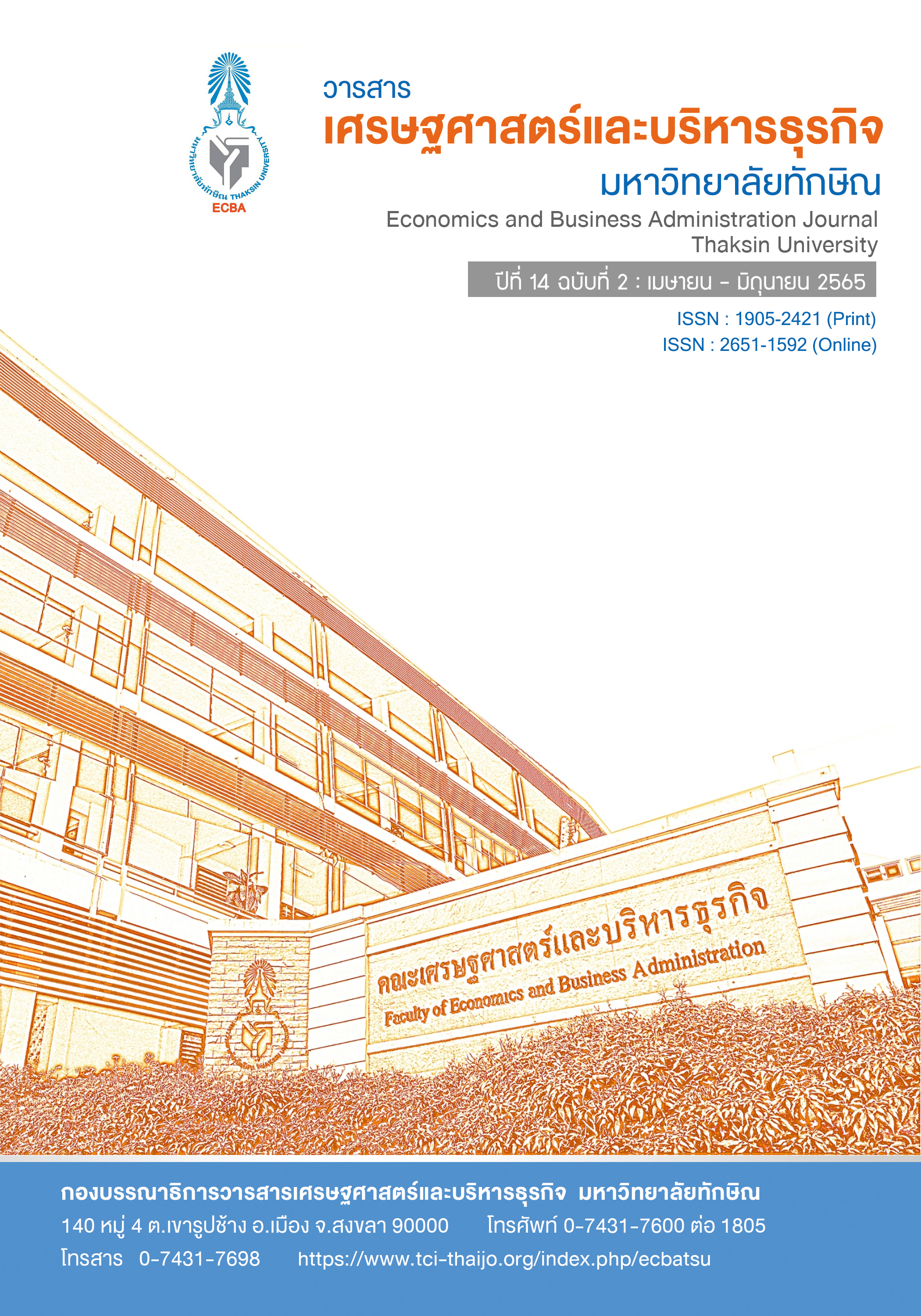Influence of Opinion Leader toward Purchase Decision of Consumer through Social Media
Keywords:
Social media, Social Commerce, Influencer, Celebrity, Purchase intentionAbstract
This research aims to study the influence of micro influencer and celebrity influencer through an online social media which affects the purchase intention towards the products on functions and hedonics, including the relationship of these 4 variables. This research employed quantitative method with random sampling on 400 online purchase experienced participants who live in Thailand via an online questionnaire.
The result shows that most of online consumers usually purchase products which emphasize the functional value and hedonic value. Additionally, there is a high level of the convenience and the best deal for consumers via an online social media. Furthermore, micro influencer has higher level of influence towards consumers' purchase intention than celebrity influencer; Beta = 0.429 and 0.255 accordingly. Both of these influencer groups are able to predict the purchase intention of consumers for 63.7 percent. This research contributing for efficient strategic marketing planning on digital platform.
References
Ajzen, I., & Fishbein, M. (1980). Understanding attitudes and predicting social behavior. Englewood Cliffs, NJ: Prentice-Hall.
Arnold, M.J., & Reynolds, K.E. (2003). Hedonic shopping motivations. Journal of Retailing, 79(2), 77–95.
Belch, G. E., & Belch, M. A. .(2012). Advertising and promotion: An integrated marketing communications perspective. New York: McGraw-Hill/Irwin.
Boone, L. E. , & Kurtz, D. L. (1995). Contemporary Marketing (8th ed.). Fort Worth, Tx: The Dryden Press.
Carroll, A. (2008) Brand Communications in Fashion Categories Using Celebrity Endorsement. Brand Management, 17(2), 146-158.
Chao-Min, C. (2012). Understanding customers’ repeat purchase intentions in B2C e-commerce: the roles of utilitarian value, hedonic value and perceived risk, Blackwell Publishing.
Childers. (2001). Hedonic and utilitarian motivations for onlines hopping behavior. Journal of Retailing, 77(4), 511–535.
Cochran, W.G. (1977). Sampling techniques (3nd ed.). New York: Wiley.
Electronic Transactions Development Agency (Public Organization) Ministry of Digital Economy and Society. (2019). Thailand Internet User Profile 2019. Retrieved from https://www.etda.or.th/publishing-detail/thailand-internet-user-profile-2019.html
Ha, J., & Jang, S. S. (2010). Perceived values, satisfaction, and behavioral intentions: The role of familiarity in Korean restaurants. International Journal of Hospitality Management, 29(1), 2-13.
Hatton, G. (2018). Micro Influencers vs Macro Influencers. Retrieved from https://www.socialmediatoday.com/news/micro-influencers-vs-macro- influencers/516896/
Hovland, C.I., & Weiss, W. (1951). The influence of source credibility on communication effectiveness. Public Opinion Quarterly 15: 635–650.
Jaruwan, J., & Khotanon, O. (2014). Important behavior and communication factors Marketing towards the purchase of consumer products from social media marketing communications. Nakhon Sawan Rajabhat University.
Kasikorn Research Center. (2017). E-Commerce and E-Market-Place. Retrieved from https://www.kasikornbank.com/th/business/sme/KSMEKnowledge/article/KSMEAnalysis/Documents/E-Commerce_E- Market-Place.pdf
Kelman, H. C. (2018). Attitude Change. Retrieved from http://www.novabizz.com//NovaAce/Self/Spiritual/Attitude_11.php-20k-
Lamb, C. W., Hair, J. F., & McDaniel, C. (2011). Marketing (11 ed.). United States: South – Western College Publishing.
McGuire, W. J., & Muiman, S. (1965). Anticipatory belie lowering following forewarning of a persuasive attack. Journal of Personality and Social Psychology, 2(4), 471-479.
Micu, C.C., & Chowdhury, T.G. (2010). The Effect of Message’s Regulatory Focus and Product on Persuasion. Journal of Marketing Theory and Practice, 18(2), 181-190.
O’Brien, H.L. (2010) The influence of hedonic and utilitarian motivations on user engagement: the case of online shopping experiences. Interacting with Computers, 22(5), 344–352.
Ohanian, R. (1990). Construction and validation of a scale to measure celebrity endorsers' perceivedexpertise, trustworthiness, and attractiveness. Journal of Advertising, 19(3), 39-52.
Phusion, S. (2011). Practice using SPSS to analyze research data. 4th edition, Mahasarakham: Mahasarakham University.
Laosiri, S. (2017). Micro-influencer strategy: A new powerful strategy that we cannot overlook. Retrieved from https://positioningmag.com/1124305.
Sangjaroen, D. (2000). The person is famous as product to publish book marketing activities. Chulalongkorn university.
Saengkaew, S. (2018). Characteristics and clarity of influencers in marketing: Thought Leader Group, Chulalongkorn Business Review, Year 40, f. 157 July - September '18.
Sayreerat, S. (2003). Modern marketing management. Bangkok : Thammasarn Company Limited.
Shostack, G.L. (1977). Breaking Free from Product Marketing. Journal of Marketing, 41(2), 73-80.
Solomon, M. (2006). Consumer behaviour : a European perspective. Prentice Hall, London.
Srisomwong, R. (2012). The Power of Influencer. QM for quality management, 18(173), 18-19.
Sukamornrat, A. (2012). Beauty blogger’s opinion leadership and awareness, attitude and buying decision making toward beauty products, Chulalongkorn university.
Swang, S. (2005). Celebrity Marketing. Retrieved from http://www.businessthai.co.th/content.php? data=408716_consumer%20wars.
The Stock Exchange of Thailand. (2019). Securities Company Statistics. Retrieved from http: //www. set.or.th/th/market/securities_company_statistics19.html
Wang, M. (2007). Effects of Online Shopping Attitudes, Subjective Norms and Control Beliefs on Online Shopping Intentions: A Test of the Theory of Planned Behavior. International Journal of Management, 24(2), 296-302.
We Are Social. (2020). DIGITAL 2020: THAILAND. Retrieved from https://datareportal.com/ reports/digital-2020-thailand.
Westwood, K. (2017). 4 Goal-Specific Ways to Measure Influencer Marketing ROI. [online] Convince and Convert: Social Media Consulting and Content Marketing Consulting. Available at: http://www.convinceandconvert.com/influencer-marketing/measure-influencer-marketing-roi/
Wongmonta, S. (1999). Analysis of consumer behavior ( 1st ed.). Bangkok : Theera Film and Scitech Co., Ltd.
Wolfson, C. (2017). Macro vs. Micro Influencers. Retrieved from https://www.revolutiondigital.com/ article/macro-vs-micro-influencers/
Zeithaml, V. A. (1988). Consumer Response to In-Store Price Information Environments. Journal of Consumer Reseach, 8(March), 357-69.
Downloads
Published
How to Cite
Issue
Section
License
Copyright (c) 2022 Economics and Business Administration Journal Thaksin University

This work is licensed under a Creative Commons Attribution-NonCommercial-NoDerivatives 4.0 International License.




